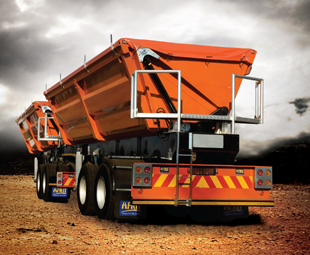Trailer industry in slow recovery mode

The global recession, labour strikes and rising steel and tyre prices combined to have a major negative impact on the trailer industry, and then as it began recovering during last year, another threat emerged – cheap Chinese competition, writes UDO RYPSTRA.
South Africa’s trailer manufacturers suffered badly during the 2008/9 global financial recession when unit sales nose-dived by more than half, with several companies and entrepreneurial outfits without short-term capital resources being forced to move into liquidation or insolvency – estimates run as high as 15 casualties. That’s after trying to undercut the big boys in the business.
Trailer sales figures dropped from about 14 900 in 2008 to about 6 250 in 2009, before climbing back to about 8 850 units last year. The figure for the first quarter of this year was about 3 400 units, meaning the trailer market is heading for, hopefully, more than 10 000 sales this year.
“I haven’t seen the figures (registrations) for April yet, and we haven’t seen a full recovery so far. Let’s say we are cautiously optimistic about 2011,” Andre Cilliers, MD of axle and suspension manufacturer BPW, who watches local trailer trends like a hawk, told FOCUS.
The recovery has been accompanied by rising input costs and seasonal strikes in the automotive industry, which saw Bloemfontein-based Trailord temporarily shut its doors in 2009. In general, the recession had trailer manufacturers reduce costs and streamline operations. Some even moved premises to make the company more sustainable. Kearney’s, for example, moved its facilities in Pietermaritzburg to Durban.
Apart from cutting overheads, profit margins and becoming more cost-productive, some were also forced to absorb part of the steep steel and tyre price increases, the tyre industry having pushed through three hikes alone this year.
SA Truck Bodies/Henred Fruehauf, one of the country’s largest trailer manufacturers, saw its production drop to below 80% of capacity during the recession and is among manufacturers who are extremely alarmed by these increases.
Says sales director Johan Serfontein, “It’s disturbing to see these increases, for example as high as 12% on tyres, coming through. But the market has recovered, for which we are grateful. We are operating at full capacity again and produce around 400 trailers a month. There is a lot of trade-in business, but fortunately we have been getting many clean orders,” he told FOCUS.
For fleet operators sitting with solid contracts and access to capital resources, it has been a buyer’s market as they could shop around and negotiate, if not bully, manufacturers into deals that the manufacturers would not have made before 2008, when the world-wide financial rot started coming to boiling point.
But for those without cash flows or solid relationships with bankers and manufacturers alike, it became a nightmare to replace vehicles, let alone expand fleets, when banks went helter-skelter by raising their lending criteria and reducing payback periods from 60 months to 48 months and less. On the other hand, to give credit where it is due, some banks extended payback periods to help valued clients through this unexpected crisis.
Serfontein says trailer prices have become realistic again, allowing for reasonable profit margins. It also allows manufacturers to invest in stock items such as steel, aluminium sheeting and tyres instead of relying on suppliers who would sell old stock at the new prices, as happened during the tyre strike action.
The market has been cleaned out, especially of fly-by-nights. The survivors are manufacturers with long and well-established track records. They have weathered similar storms before and have kept going. They have also been expanding their trailer refurbishment, repairs and other back-up facilities such as parts agency networks.
Among them are GRW Engineering, which launched a special division, GRW Services, this earlier this year and Durban-based Serco, well-known for its top-class refrigerated and dryfreight trailers and rigids, which has just recently completed extensive facility expansions in Cape Town, SA’s refrigerated cargo hub.
Most trailers can last for up to 12-15 years if they are looked after, but rigid and side tippers used in mining and construction operating over rough terrain last only 3-5 years or, at least, need bins replacements. As customers deferred their replacement programmes, manufacturers made up for the decrease in local demand for new trailers through their trailer refurbishment divisions.
The tipper market witnessed a glut during 2009 but, fortunately, the tide turned last year, with several manufacturers benefiting from an upturn in the international commodities market. Those heavily involved in the mining and construction market, such as Afrit, SA Truck Bodies/Henred Freuhauf, Top Trailers and Paramount Trailers were among the first to benefit from a pick-up in the demand for side-tippers and flatdecks of which a fair number were for the export market.
Innovative design
SA’s trailer designers are innovative, with new designs regularly being brought to market. In the case of tippers, chassis modifications, new hydraulic systems, newly shaped tipper bodies and even a multi-purpose trailer have been launched. In addition Top Trailers, designers of the original Sloper, introduced sliding bin tippers, tridem side tippers and interlink side tippers.
The latter was in response to a radical a new concept from Buks van Rensburg, owner of Buks Haulage of Zambia, who hauls copper concentrates on the Copperbelt one way, and sulphuric acid or cooking oil the other depending on what the client requires.
As reported in our February issue, Top Trailers, in collaboration with Flexi Manufacturers, the well-known producers of liquid and chemical tankers, has produced the BucSta tridem semi-trailer, which features a 28,5-ton side-tipping bin between two 8 000-litre tanks. Other versions of the BucSta feature a flatbed in the middle to transport copper plates or to house a 20 ft container.
Another surprise came last month when GRW Engineering revealed its now much talked-about Imvubu (tough as a rhino) seven-compartment, 50 000-litre, aluminium tanker, a cost effective solution for fuel tanker operators who want to deliver sealed (SPD) or metered consignments, or both, to fuel stations. This design too incorporates the latest instrumentation equipment and vehicle components from the US and Europe, including BPW axles, suspension and the ECO Disc brake system, released last year (see pages 42-45).
Another interesting development is that Durban-based Serco has now also come up with new interlink trailer combinations for Bakers and Manline with stand out features such as the new inter-leading double centre doors and ramp, a sliding fifth wheel and an aluminium roll-over door, all of which allow a forklift to drive through from the rear trailer to the front. Using a new coated birchply floor and offering various options for throughloading, Serco has produced an interlink combination lighter than what had been previously offered. A lifting axle system is also fitted to both trailers.
Says Serco MD Clinton Holcroft: “Serco has built Bakers a prototype truck body based on their requirements for a new logistics contract for Clicks, which involves trolleys being used to move a wide range of consumer goods.
“We investigated what leading logistics companies were using overseas and introduced a new trolley strapping system together with robust interior bulkhead protectors to help prevent damage from the trolleys. The prototype was a success and resulted in further orders,” Holcroft said.
Exports grow
Much of the trailer demand from sub-Saharan countries is due to an upswing in the commodities market and demand for African minerals by China and India in return for funding infrastructure projects all over the African continent. Additional financial support is also coming in from the World Bank, the EU and African Development Bank.
Afrit, South Africa’s leading trailer builder with about 25% market share, SA Truck Bodies, Top Trailers and Kearneys have been establishing a strong market presence across southern and central Africa including, among others, Botswana, Zambia, Malawi, Mozambique, Angola – and even as far away as the Democratic Republic of Congo (DRC), Kenya, Nigeria and Ghana
But here they can expect to face increasing competition from Chinese manufacturers such as Mica, who has already gained a foothold in Northern and Central Africa, and is now moving south with a full range of trailers, including car carriers and 120-ton lowbeds, costing about half the price of what they can be produced for locally.
Several fleet operators and trailer manufacturers have commented on the high quality of some of the trailers, but also the bad quality of others. While their long-term reliability has yet to be proven, one thing against them for sure is the lack of backup infrastructure. Yet they are here and are a reality that must be considered.
BPW Axles exports axles into the region and has spotted Chinese trailers with BPW or Chinese axles, which some local trailer builders have been importing anyway as they are cheaper.
“Chinese trailers are popping up all over the place, including Mozambique,” said Cilliers.
As Serfontein put it: “Don’t underestimate them; they are a threat.”
Serco’s capacity for undercover work increases
Expansions at Serco’s Cape Town premises have seen the trailer manufacturer’s under-cover work area increase by 690 m2, while its yard surface has been upgraded. The new roofed area will improve efficiencies, particularly in the rainy season. In the past, work had to be curtailed during inclement weather.
A total of 1 974 m2 of concrete was thrown to produce the new floor area, allowing for vastly improved movement of equipment, and thus enhanced customer service.
Several “green elements” were incorporated into the facility during the expansion project. Serco MD Clinton Holcroft says the company made a conscious decision to use this opportunity to reduce its carbon footprint. Large sections of the roof were fitted with clear translucent sheeting to help reduce electricity consumption, while clear sheeting was retrofitted to sections of the existing factory to maximise the use of natural light.
“Water storage tanks with a capacity of 20 000 litres were also installed as part of a water harvesting project for the washing of vehicles,” he adds. “This will reduce demand for municipal water.”
Similar environmentally friendly additions were introduced during Serco’s Durban factory expansion project last year. “This is an indication of our commitment to a sustainable future for all,” says Holcroft.
Published by
Focus on Transport
focusmagsa



